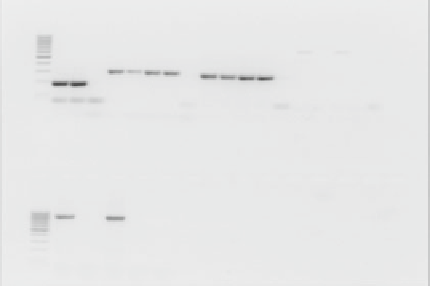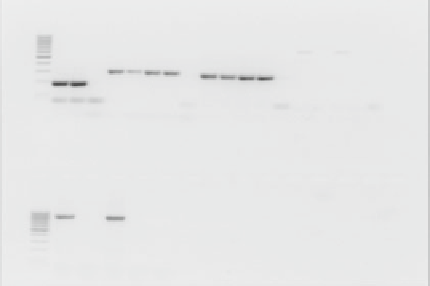Biology Reference
In-Depth Information
M 1 2 3 4 5 6 7 8 9 10 11 12 13 14 15 16 17 18
M: Mass Ruler
TM
DNA Ladder Low
Range, (Fermentas)
Lanes 1, 6, 11, 16, 21:
S.
typhimurium
; 2, 4, 9, 14, 19:
S.
typhimurium
ATCC 14028; 3, 8, 13,
18, 23: negative control; 7, 12, 17,
22:
S. napoli
; 5, 10, 15, 20: wild-
type strain
S
.
enteritidis
phoP
fliC
invA
spvC
M 19 20 21 22 23
spvR
Fig. 25.2 Pulsed-field gel electropherogram of the amplicons
fliC
,
invA
,
phoP
,
spvC
, and
spvR
in
the isolates of
S. enterica
identified the serotype, and the virulence factors examined.
Escherichia
adecarboxylata, E. hermannii
,
Enterobacter cloacae
, and
Citrobacter youngae
,
microorganisms widespread in the environment but not necessarily related to
fecal contamination, were isolated from 19.0% of the frozen samples.
Shewanella
putrefaciens
, a spoilage bacterium highly widespread in frozen and chilled fishery
products, was isolated in PG H
2
O 11.
25.4 Discussion
The values related to mesophilic aerobic counts for fresh products, recommended
by the International Commission on Microbiological Specification for Foods
(ICMSF), must be below 7 log CFU/g. Twenty percent of the samples of
A. minuta
and the 8.7% of the samples of
S. pilchardus
exceeded this limit. This finding could
be due to the habitats where these species live: “rossetto” lives in sandy and muddy
seabeds at a depth of 80 m, while “bianchetto” lives generally between 25 and 35 m
(Relini et al.
1999
; Lucchetti
2006
).
The values related to psycrophilic aerobic count recommended by the Frozen
Food Institute for frozen products are between 5 log CFU/g and 6 log CFU/g. In the
survey, 14.3% of the samples, both ice fish and defreezing water, exceeded 6 log
CFU/g. Considering that freezing causes a numerical reduction in the
microorganisms initially present in the food, the obtained results show that these
species could be fished in coastal waters, which are more polluted. The obtained
results with the MPN method prove low hygienic levels, especially in frozen
products, allegedly due to the deterioration of the defreezing water and subsequent
handling.






